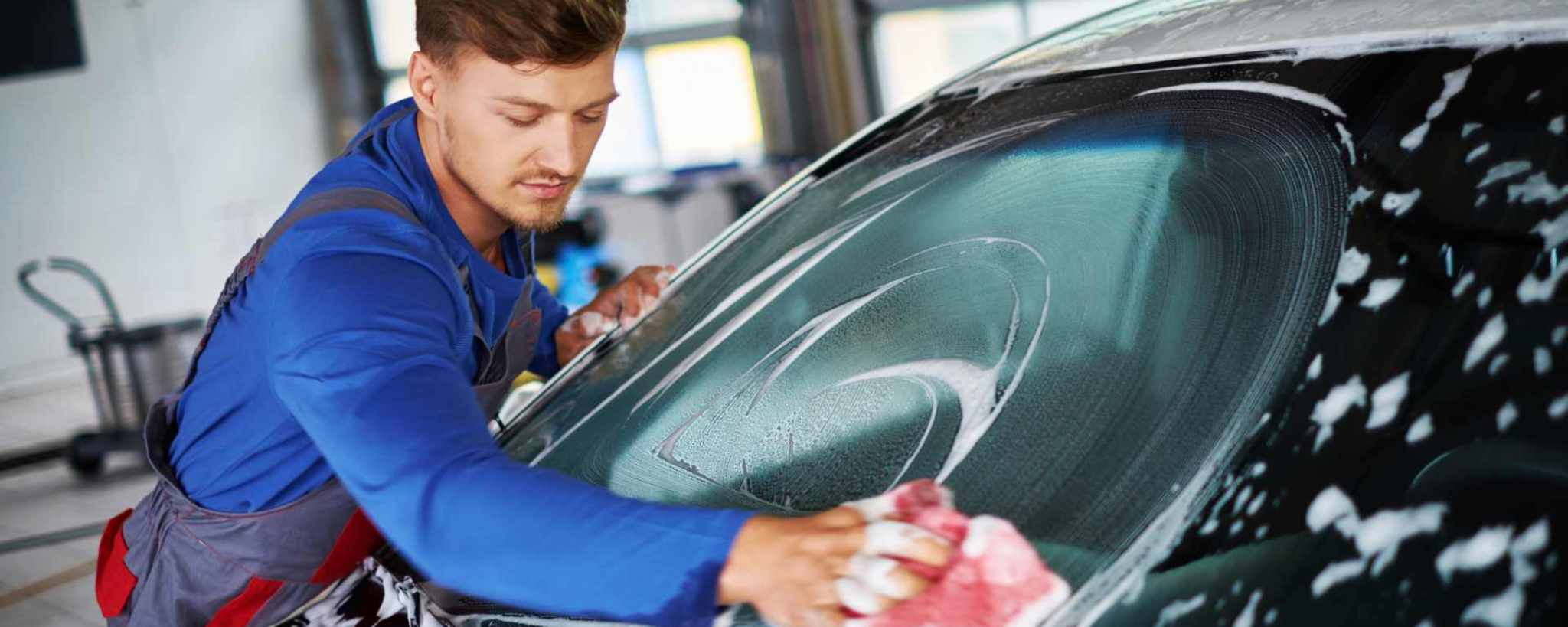How to Clean Car Windshield Inside and Out (Like a Pro)
Find out how to clean the interior and exterior of your car windshield with car detailing experts.

Written by:
Parham Koukia
Reviewed By:
Editorial Team
Published: April 21, 2025
Updated: October 14, 2025
Use AI to summarize this article:
The best way to clean windshields inside and outside of your car is to use an ammonia-free windshield cleaner paired with a microfiber towel. These tools not only ensure effective cleaning but also protect your glass from streaks and damage.
And, if you want to achieve a finish like a professional detailing service, here’s a step-by-step guide to get a super clean windshield that enhances clarity and safety while driving!
What You’ll Need to Clean Your Windshield
Essential Tools and Materials
- Ammonia-free automotive glass cleaner: Safe for tint and clear coat.
- Isopropyl alcohol (70% or higher): Effective for degreasing oily films.
- Magic Eraser or clay bar: For bonded contaminants or haze on the windshield.
- Lint-free microfiber towels: Use separate ones for cleaning and drying.
- Spray bottle with warm water: Helps loosen residue and prime the surface.
- Anti-fog treatment: Adds a protective barrier inside your windshield.
Best Way to Clean the Inside of Your Windshield
Step 1: Wipe Away Loose Dust and Debris
Begin from the passenger seat to get the best angle. Use a clean, dry microfiber towel to sweep away dust and pet hair. Pay attention to the lower corners near the dashboard where buildup is common.
Step 2: Degrease Using Alcohol or Magic Eraser
Apply a small amount of isopropyl alcohol to a new section of your towel or use a damp Magic Eraser. Wipe the interior glass in circular motions, especially where the dashboard meets the windshield (the primary zone for off-gassed residue).
Step 3: Apply Glass Cleaner the Right Way
Apply the cleaner to the towel instead of spraying directly on the glass. This prevents drips from reaching the dash or pooling at the edges.
Use vertical strokes after circular motion to ensure complete coverage.
Step 4: Dry and Buff for a Streak-Free Finish
Take a second, dry microfiber towel and buff the entire windshield using straight, overlapping motions. This final pass removes leftover moisture and prevents glare when driving at night.
Step 5: Apply Anti-Fog if Needed
Finish with an anti-fog solution on the interior surface of your front windshield. It creates an invisible layer that resists moisture buildup, especially useful in humid climates or colder months.
How to Clean the Outside of Your Windshield
Step 1: Work in the Shade and Remove Debris
Park in a shaded spot. Direct sunlight can cause the cleaner to evaporate too quickly, leading to streaks. Use a microfiber towel to wipe away loose dirt, pollen, or sand before applying any product.
Step 2: Wash, Clay Bar, and Dry the Glass
Spray the glass with warm water, then gently glide a clay bar across the surface. This step lifts stuck-on contaminants like bug residue and bird droppings that regular cleaners can’t remove. Rinse and dry with a clean towel.
Step 3: Apply Glass Cleaner and Buff
Spray your ammonia-free cleaner onto a towel, not the glass, and clean in overlapping circular motions. Follow up with vertical strokes to catch any missed streaks.
Step 4: Optional: Wax Your Windshield for Protection
Apply a thin layer of automotive wax using a damp towel. Buff after a few minutes with a finishing towel. Wax adds a hydrophobic coating, improving rainwater runoff and making it harder for dirt to bond to the glass.
Check our handy YouTube Short on exactly how to clean windshields:
How to Clean Windshield Wiper Blades (Without Damaging Them)
- Pull the driver and passenger side wiper blades away from the windshield. Use a towel soaked with glass cleaner to wipe along the rubber edge.
- Strictly avoid using alcohol, as it can dry out the rubber.
- Clean wiper blades prevent streaks and extend the life of your freshly detailed glass.
Tips to Prevent Haze, Fog, and Streaks
Avoid Ammonia-Based Cleaners
Ammonia-based cleaners can degrade tinted film and leave a chemical residue that increases glare.
Detailed explanation on why not to use ammonia-based cleaners for the windshield.
Use the Two-Towel Method
One for applying the cleaner, another for drying. This avoids transferring dirt back onto the glass and ensures a haze-free finish.
Park Smart and Reduce Off-Gassing
Whenever possible, park in the shade or crack the windows slightly to reduce heat buildup and dashboard vapors. This small step prevents oily film from reappearing too quickly.
Can You Use Windex or Household Cleaners on Your Windshield?
Most household glass cleaners, including traditional Windex, contain ammonia, a chemical that weakens window tint and leaves behind streaks on automotive glass. If you're using Windex, opt for an ammonia-free version, especially on tinted windows. Automotive-specific glass cleaners are designed to handle road grime, not just fingerprints.
How Often Should You Clean Your Car Windshield?
As a general rule, clean the interior glass once every two weeks, and the exterior every week (or more often if you drive in dusty, salty, or rainy environments). Regular cleaning removes haze, grime, and environmental buildup that can reduce visibility or damage wipers.
Common Mistakes to Avoid When Cleaning Your Windshield
- Using paper towels, which can leave lint on the surface.
- Spraying cleaner directly on the glass can drip onto the dashboard.
- Cleaning under the sun or attempting to clean hot glass.
- Neglecting the wiper blades
When to Call a Professional Car Detailer
If you’re dealing with permanent haze, hard water spots, or embedded dirt that won’t budge, professional detailing services can restore the clarity. Detailers use clay bars, polishing compounds, and specialty tools to deep-clean auto glass safely. With Panda Hub, you can book a mobile expert who’ll come to your driveway to deliver exceptional results.

Parham Koukia
Lead Car Detailer / Operations Manager
With nearly 15 years of hands-on detailing experience, Parham has become a trusted authority in the auto care world. His work is regularly spotlighted in leading outlets like CNN, GoBankingRates, and Family Handyman. Parham likes to share his knowledge to offer in-depth tips on equipment selections, seasonal car care, and some secret car cleaning tips used by detailers in the real world!
Read more
